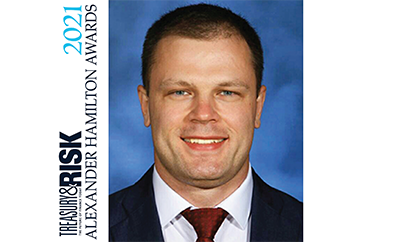
Bristol Myers Squibb’s (BMS’s) 2019 acquisition of Celgene Corporation was one of the largest pharmaceutical acquisitions in history. Not surprisingly, combining two behemoths in a tightly regulated market sector brought challenges, some of which came to roost in the corporate treasury function. The newly combined organization was running enterprise resource planning (ERP) systems from two different vendors and was using those ERP systems to manage twice as many legal entities as either company had managed previously.
“We suddenly had 260 legal entities across 60 countries, and we needed to hedge 20 currencies,” explains Sandra Ramos-Alves, senior vice president and treasurer for BMS. As the company’s landscape of exposures expanded, Ramos-Alves and her team embarked on a multipronged initiative to strengthen and streamline financial risk management companywide. One key aspect of the project was improving insights into currency risk.
“Corporate balance sheet FX [foreign exchange] risk increased with the acquisition, and quantifying risk or explaining P&L volatility became increasingly difficult with the technology and processes we had in place at the time,” Ramos-Alves says. The newly combined organization did not have a system providing single-pane-of-glass visibility to currency risk at the corporate level. This challenge was magnified by the fact that BMS used the daily FX rate for balance sheet remeasurement, so every day that they waited to hedge an exposure created additional FX risk for the BMS P&L. The company had historically hedged balance sheet FX once a month, even though exposures were changing on a daily basis.
BMS’s treasury team decided to automate the balance sheet FX hedging process, from identification of exposures in the company’s ERP systems to hedge recommendations, and from uploading approved external trades into a trading platform to the creation of internal allocations associated with each external trade. The treasury group evaluated a variety of options for achieving this level of automation and implemented AtlasFX.
“We discovered that many of our legal entities had inconsistent variants set up in their ERP systems, so we required a custom feed for each entity,” says Ravi Patel, director of financial risk management for BMS. “Additionally, many of the entities’ G/L [general ledger] accounts had transactions from historical currencies that needed to be excluded.” The treasury team set up the data feeds into AtlasFX with these complications in mind. By increasing accuracy in the data aggregation process, they improved their ability to measure the overall company’s daily FX exposures.
At the same time, the BMS treasury team connected AtlasFX to their 360T trading platform and their FIS Quantum treasury management system so that FX trades could flow automatically from AtlasFX to both systems, along with the hedges’ allocations to internal entities. These straight-through data flows replaced the team’s legacy process of creating an Excel spreadsheet with requested trades, distributing it for individual review of the trades, and then manually allocating the transactions within the treasury management system.
With these systems in place, the treasury team also significantly accelerated the pace of their cash flow hedging program in 2023 to mitigate currency headwinds and reduce volatility within the company’s P&L statement. The team completed BMS’s 2023 cash flow hedging by early Q3/2022, including placing the maximum hedges permitted by accounting regulations on the currencies in the cash flow hedging program. They also began purchasing FX options to participate in potential foreign currency appreciation.
In addition, BMS treasury initiated a cross-currency swap strategy to hedge the company’s net investment in several currencies. “We identified an opportunity to synthetically convert a net investment hedge from a long-dated euro bond into a series of shorter-dated cross-currency swaps, enabling the company to monetize the borrowing rate differential between U.S. dollars and euros,” says Patel. “These hedges generated interest-expense savings for 2023 and 2024, while providing additional restructuring flexibility for future market opportunities. This strategy ensured that, as those net assets change over in the future, we won’t have to react by de-designating our bonds. We can just not renew our cross-currency swaps.”
For assistant treasurer Keith Gaub, the introduction of both the cross-currency swaps and the FX options demonstrates the benefits of taking a strategic approach to financial risk management. “Collectively, as a treasury team and up through our CFO, we shared a view that interest rates would remain higher for longer,” he says. “As a result of this perspective, we used shorter-tenor trades to hedge our risk in the event we were wrong, but created a portfolio that would turn over quickly, allowing us to seek a better entry point to execute longer-dated trades. It’s an example of how we take an instrument and use it in its designated way to hedge an exposure, while leaving ourselves flexibility to take advantage of dynamic and rapidly changing market conditions.”
Ramos-Alves sees mitigating the impact of currency volatility on both the P&L and the balance sheet as a means of keeping BMS focused on its core business. “We have reduced the impact of currency volatility on our financials by multiple cents in EPS [earnings per share] every quarter,” she says. “This enables corporate leadership to focus on what’s really important: delivering medicines to patients, innovating, and investing in business development. And our earnings calls can focus more fully on our products, rather than on explaining the potential EPS impact of non-operational issues like FX.”

A second key dimension of BMS’s financial risk management initiative revolved around better mitigating the company’s counterparty credit risk. BMS has always been conservative about diversifying its counterparty risk, and when Silicon Valley Bank and Credit Suisse failed in the spring of 2023, senior management began requesting daily updates on corporate-level exposures to different banks. The treasury group used Microsoft Excel to aggregate data across a range of software systems to capture derivatives, deposits, and investments with each counterparty.
“A lot of healthcare companies, including some of our acquisitions, used Silicon Valley Bank,” Ramos-Alves says. “Our exposure was small, but we saw the need to revamp our processes so that we could easily view companywide counterparty risk at the press of a button, should the question come up from our CFO or the board.”
The treasury team had already begun to pull data on counterparty exposures into a dashboard, but the Silicon Valley Bank meltdown accelerated that process. “The external environment prompted us to improve that dashboard and integrate it with more systems so that we could come up with one number for the entire company—including both the cash side and the derivative side—in real time,” Ramos-Alves says.
Information about cash deposits flows from BMS’s banking partners into FIS Quantum, and from there into a data lake. Mark-to-market information flows from BMS’s Reval system into the data lake. And the counterparty risk dashboard taps into that data lake. “So, when we look at counterparty exposures, we are looking at the mark to market on our derivatives as well as our cash,” Ramos-Alves says. “If management wants an update on our exposure to a particular banking counterparty, we can pull up current information right away.”
The third area of financial risk that BMS tackled within this initiative involved its non-qualified deferred compensation (NQDC) plan, a benefit provided to certain high-earning employees. “Because the IRS has annual limits on how much individuals can defer to their 401(k), BMS established the NQDC so that participants can defer and invest a higher portion of their salaries toward retirement,” said Ashish Saraogi, senior director of benefit investments and international treasury. “At the start of the year, they designate a percentage of their salaries to defer, and they can choose among 12 different funds for their NQDC ‘investments.’”
BMS withholds the specified percentage from each participant’s salary throughout the year, and when the employee leaves the company, BMS owes them the deferred salary plus the amount that their chosen funds have earned over time. However, Saraogi explains, “unlike a 401(k), the NQDC investments are only notional—there are no assets behind them. So, if we retained $100 million in deferred compensation within the NQDC and plan investments achieved 25 percent growth through the years, then when those employees retired, BMS would be on the hook for the original $100 million plus an additional $25 million. That’s a significant exposure we needed to manage.”
————————————————————
See also:
- Highly Customized FX Risk Management System Brings ‘Infinitely’ Better Results Than Excel
- How One of the World’s Largest Conglomerates Brought FX Under Control
BMS treasury considered a few options for mitigating this risk. One option was to buy assets, as a 401(k) plan does. “But that was not cash-efficient, and there were some tax implications and other nuances which made that approach less attractive,” Saraogi says. “After ruling out that option, we went down the road of looking for a solution that would not completely de-risk the transaction—because you can’t do that unless you’re directly investing in the assets—but would smooth out the impact of changes in the funds’ value.”
The team settled on implementing a total return swap, or TRS. “It is an equity derivative contract where we pay our bank counterparty a financing charge of SOFR plus a spread based on the NQDC balance, and the bank settles with us on the appreciation or depreciation of our basket of assets,” Saraogi says. “We told banks we needed the returns on the 12 funds our employees choose among, so at the end of the month, either they pay us the funds’ gains less the financing charge or we pay them the funds’ losses plus the financing charge. In this way, our TRS mimics the movement of the NQDC plan ‘investments’ and we reset or rebalance our swap notional monthly to match the plan investments.”
The treasury team opened the TRS to competitive bids from multiple banks and selected a counterparty. “Ultimately, the returns on the swap offset the changes in what we owe the NQDC plan participants, and gains or losses on the swap are tax-deferred until we make the distributions to participants,” Saraogi explains. “We still have exposure to the equity returns from the fund perspective, but the amount we receive from the bank—whether it’s a gain or a loss—will cancel out the change in our liability, so we are ultimately left with only the financing charge. This makes the cost of the NQDC plan easier to forecast and significantly less volatile, so we can eliminate some of the noise on our P&L from quarter to quarter.”
All aspects of BMS’s financial risk management initiative were complex and time-consuming. “Implementing these new systems and processes took a lot of effort,” Saraogi says. “But every project that we completed freed up more of our time, so the investment was worthwhile. We are a leaner team than we were a few years ago, due to not replacing some staff members who left, and yet we are getting more done than we used to.”
Adds Gaub: “This creates more time for strategic work, such as looking at the portfolio’s mark to markets and seeing whether there are restructuring opportunities, or reconsidering more broadly how we layer our future FX trades. Rather than being limited to exclusively hedging the exposures, we can step back and say, ‘Are the hedges we have optimal? Should we be doing things differently?’ As a group of treasury professionals, we can focus on analyzing and challenging the way we work to deliver maximum value for the enterprise.”
“What we found in this initiative is that the changes we enacted enabled people to continue to develop, learn, and grow professionally,” Ramos-Alves concludes. “We have done a lot, but we are not finished. We have completed a part of the journey, even as we continue to look for innovative ideas and new ways to simplify, automate, and deliver value.”

© Touchpoint Markets, All Rights Reserved. Request academic re-use from www.copyright.com. All other uses, submit a request to [email protected]. For more inforrmation visit Asset & Logo Licensing.



